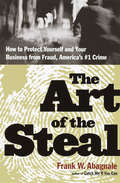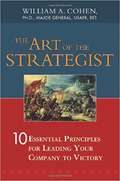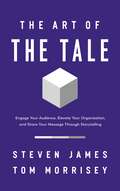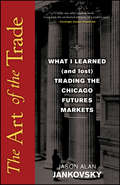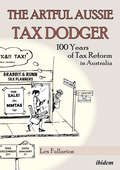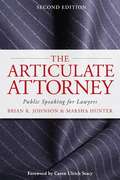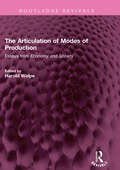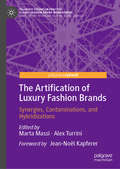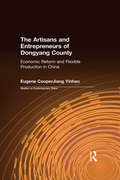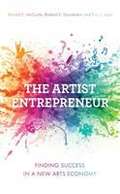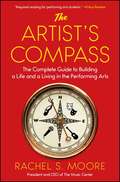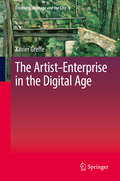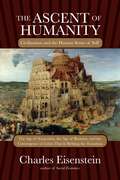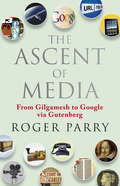- Table View
- List View
The Art of the Steal: How to Protect Yourself and Your Business from Fraud, America's #1 Crime
by Frank W. AbagnaleThe world--famous former con artist and bestselling author of Catch Me if You Can now reveals the mind--boggling tricks of the scam trade--with advice that has made him one of America's most sought--after fraud--prevention experts."I had as much knowledge as any man alive concerning the mechanics of forgery, check swindling, counterfeiting, and other similar crimes. Ever since I'd been released from prison, I'd often felt that if I directed this knowledge into the right channels, I could help people a great deal. Every time I went to the store and wrote a check, I would see two or three mistakes made on the part of the clerk or cashier, mistakes that a flimflam artist would take advantage of. . . . In a certain sense, I'm still a con artist. I'm just putting down a positive con these days, as opposed to the negative con I used in the past. I've merely redirected the talents I've always possessed. I've applied the same relentless attention to working on stopping fraud that I once applied to perpetuating fraud."In Catch Me if You Can, Frank W. Abagnale recounted his youthful career as a master imposter and forger. In The Art of the Steal, Abagnale tells the remarkable story of how he parlayed his knowledge of cons and scams into a successful career as a consultant on preventing financial foul play--while showing you how to identify and outsmart perpetrators of fraud.Technology may have made it easier to track down criminals, but cyberspace has spawned a skyrocketing number of ways to commit crime--much of it untraceable. Businesses are estimated to lose an unprecedented $400 billion a year from fraud of one sort or another. If we were able to do away with fraud for just two years, we'd erase the national debt and pay Social Security for the next one hundred years. However, Abagnale has discovered that punishment for committing fraud, much less recovery of stolen funds, seldom happens: Once you're a victim, you won't get your money back. Prevention is the best form of protection. Drawn from his twenty-five years of experience as an ingenious con artist (whose check scams alone mounted to more than $2 million in stolen funds), Abagnale's The Art of the Steal provides eye-opening stories of true scams, with tips on how they can be prevented. Abagnale takes you deep inside the world and mind of the con artist, showing you just how he pulled off his scams and what you can do to avoid becoming the next victim. You'll hear the stories of notorious swindles, like the mustard squirter trick and the "rock in the box" ploy, and meet the criminals like the famous Vickers Gang who perpetrated them. You'll find out why crooks wash checks and iron credit cards and why a thief brings glue with him to the ATM. And finally, you'll learn how to recognize a bogus check or a counterfeit bill, and why you shouldn't write your grocery list on a deposit slip.A revealing look inside the predatory criminal mind from a former master of the con, The Art of the Steal is the ultimate defense against even the craftiest crook.
The Art of the Strategist: 10 Essential Principles For Leading Your Company To Victory
by William CohenFrom ancient battlefields to the modern business landscape, competitors have tried innumerable approaches to conquering adversaries. Success for the victors has taken many forms and traveled many paths, but at its heart, winning strategy can be boiled down to ten universal principles. When learned and implemented, these principals become powerful drivers of business excellence. Renowned strategy expert William A. Cohen, whose considerable experience in the military, corporate, and academic sectors forms the basis for The Art of the Strategist, presents the timeless lessons of: * commitment to a definite objective * seizing and maintaining the initiative * economization to mass (concentration of resources) * positioning * surprise * multiple simultaneous alternatives * the indirect approach * simplicity * timing * exploiting success With examples including the conquests of Hannibal and Alexander the Great, the political triumphs of Bill Clinton, George W. Bush, and Arnold Schwarzenegger, and the business successes of internet giant VeriSign and other high-profile companies, The Art of the Strategist proves how superior strategy trumps other factors in almost every competitive arena. The ten lessons in turn form a roadmap to decisive victory in business.
The Art of the Tale: Engage Your Audience, Elevate Your Organization, and Share Your Message Through Storytelling
by Steven James Tom MorriseyUnleash the power of storytelling to transform your talks, speeches, and presentations—whether your audience is a boardroom of executives, a classroom of students, or an auditorium full of eager listeners.Everyone, regardless of their background and training, can improve their storytelling abilities. But what is a story? How can you tell it in a way that delights and informs your listeners? Take a journey into the keys to great storytelling with two of the country&’s top experts on story presentation and speech writing.In The Art of the Tale, expert storytellers Steven James and Tom Morrisey team up and tap into their lifetimes of experience to show you how to prepare stellar presentations, tell stories in your own unique way, adapt your material to different groups of listeners, and gain confidence in your ability as a speaker. In this book, you&’ll learn why: practice doesn&’t make perfect.you should never tell the same story twice.there is no right way to tell a story.it&’s best to avoid memorizing your stories. You&’ll also find helpful hints on: gaining confidence in your ability as a storyteller.connecting with your audience.matching your expectations with those of your listeners.understanding what makes a good story.drawing truth out of stories you wish to tell.crafting and remembering stories.shaping your memories into inspiring stories.Learn how to tell stories more effectively, lead and teach more creatively, and prepare your message in less time by using this unique resource provided by two of the nation&’s premier communicators, who tap into their experience to share a lifetime&’s worth of insights and expertise.
The Art of the Trade
by Jason Alan JankovskyThe Art of the Trade is a searing portrait of the futures and options industry as seen through the eyes of someone who has participated in this arena for more than twenty years. On one level, it's a brutally honest, no-punches-pulled look at the individuals and institutions that comprise this unique community. On another level, The Art of the Trade is a personal story of the challenges author Alan Jankovsky faced as he battled the markets, the brokerage industry, and his own early penchant for self-destruction.
The Artful Aussie Tax Dodger: 100 Years of Tax Reform in Australia
by Lex FullartonIn The Artful Aussie Tax Dodger, Lex Fullarton studies the impact of 100 years of taxation legislation in Australia, from 1915 to 2016. He finds that despite the lessons of a century of taxpayers and administrators' actions and reactions, old habits are hard to break. Driven by the winds of various political and social interests, Australia embarked on a century of tax reform from the moment when its first Income Tax Assessment Act was introduced. <P><P>Fullarton discusses the oldest of tax planning entities, the British Trust, the introduction of Australia's 'reformed' consumption tax, its VAT, referred to as Goods and Services Tax, an analysis of tax avoidance schemes, and finally government taxation reform. This book looks at how Australia's tax legislation was grounded, added to, avoided, and evolved, until it went 'Back to the Future'. It is a collection of studies compiled from experience and research conducted over twenty years of involvement in taxation law in rural and remote Australia.
The Artful Economist
by Ruth Towse Ilde RizzoThis book reassesses central topics in cultural economics: Public finance and public choice theory as the basis for decision-making in cultural and media policy, the role of welfare economics in cultural policy, the economics of creative industries, the application of empirical testing to the performing arts and the economics of cultural heritage. Cultural economics has made enormous progress over the last 50 years, to which Alan Peacock made an important contribution. The volume brings together many of the senior figures, whose contributions to the various special fields of cultural economics have been instrumental in the development of the subject, and others reflecting on the subject's progress and assessing its future direction. Alan Peacock has been one of the leading lights of cultural economics and in this volume Ilde Rizzo and Ruth Towse and the other contributors ably capture the import of his contributions in a broader context of political economy. In doing so, they offer an overview of progress in cultural economics over the last forty years. Tyler Cowen, Professor of Economics and Director of the Mecatus Center, George Mason University, Fairfax, Virginia, USA A fitting tribute to Professor Sir Alan Peacock's inspiring intellect leadership and his outstandingly rich and varied legacy in the domain of cultural economics, this book draws together illuminating analyses and insights from leading cultural economists about the role and value of this dynamic and increasingly policy-relevant field of enquiry. Gillian Doyle, Professor of Media Economics and Director of Centre for Cultural Policy Research, University of Glasgow, UK
The Articulate Attorney: Public Speaking For Lawyers
by Brian Johnson Marsha Hunter Caren StacyAddressing the distinctive communication skills expected of attorneys--and based on three decades of experience coaching lawyers--this manual of practical, useful solutions integrates cutting-edge discoveries in human factors, linguistics, neuroscience, gesture studies, and sports psychology. These techniques will transform any attorney into a more confident speaker, whether addressing colleagues in a conference room, counseling clients in a boardroom, or presenting a CLE in a ballroom. Including tips on bringing the presentation off of one's notes and using direct eye contact, the book answers such common questions as: How do I channel nervous energy into dynamic delivery? What is a reliable way to remember what I want to say? How do I stop saying "um" and think in silence instead? and Why is gesturing so important? Topics are divided into chapters on the body, the brain, and the voice, with an extra section specifically dedicated to practice.
The Articulation of Modes of Production: Essays from Economy and Society (Routledge Revivals)
by Harold WolpeFirst published in 1980, The Articulation of Modes of Production is primarily concerned with the concept of articulation of modes of production and with the analysis of a number of different social formations utilizing this concept. The emphasis is on the relationship between capitalist and other modes of production and on accounts of specific social formations which demonstrate the analytical power of the concept, but at the same time reveal a number of as yet unresolved problems. The introduction to the collection takes these problems at its starting point, and through a discussion of the theoretical literature, provides the basis for a more rigorous and complete analysis of social formations. This book will be of interest to students of economics, social policy, and history.
The Artification of Luxury Fashion Brands: Synergies, Contaminations, and Hybridizations (Palgrave Studies in Practice: Global Fashion Brand Management)
by Marta Massi Alex TurriniDespite being vastly different both socially and economically, art and fashion are increasingly converging to collaborate in mutually advantageous ways. This book discusses the mutual benefits of collaboration through analysis of successful case studies, including corporate art collections and museums, patronage and sponsorship initiatives, and art-based brand management in the fashion sector. It provides a categorization of the strategies that fashion firms employ when they join the art world and illustrates how art and fashion brands can interact strategically at different levels. This book will be a valuable resource to researchers, providing an enhanced understanding of the potential of artification for managing brands and products.
The Artisans and Entrepreneurs of Dongyang County: Economic Reform and Flexible Production in China
by Terry L Cooper Yinhuo JiangThe book represents a continuation of research begun by Cooper in Hong Kong in the early 1970s among expatriate artisan furniture makers and woodcarvers from Dongyang County, Zhejiang Province. He now sets out to investigate the fate of the same craft in the hands of the same folk under totally different socio-economic conditions in their native county in communist People's Republic of China.
The Artist Entrepreneur: Finding Success In a New Arts Economy
by Ronald C. McCurdy Richard E. Goodstein Eric J. LapinThe twenty-first-century art world offers performers and professionals an unrivaled variety of opportunities, but also requires a never-before-seen investment in skills beyond artistic talent. Today's artists must build sustainable success in this new arts economy through collaborative big-idea thinking that celebrates a continual engagement in creative process. <p><p> Presenting creativity as a process with unlimited applications, The Artist Entrepreneur empowers young artists to step into the new arts landscape and build their own careers. Along the way, the book demystifies essential business skills from self-promotion, branding, touring, and intellectual property exploitation to contracts, revenue sources, and bookkeeping. Addressing students from across the artistic spectrum, this book offers practical exercises to develop individual skills while empowering a new generation of artist entrepreneurs with the promise of a new arts economy.
The Artist's Compass: The Complete Guide to Building a Life and a Living in the Performing Arts
by Rachel MooreAn inspiring, real world guide for artists in the classic bestselling tradition of What Color Is Your Parachute? that shows how to build a successful, stable career in the performing arts, from the President and CEO of the Los Angeles Music Center who has carved her own success through her creative talent and business skill.While performing artists have many educational opportunities to perfect their craft, they are often on their own when it comes to learning the business skills necessary to launch their careers. At the end of the day, show business is, well, a business. In The Artist's Compass, Los Angeles Music Center CEO Rachel Moore shares how to make life as a performer more successful, secure, and sustainable by approaching a career in the arts like an entrepreneur. A former dancer in the American Ballet Theatre's corps de ballet, Moore knows firsthand what it's like to struggle and succeed as an artist. Now in an offstage role as CEO, Moore shares the hard-won lessons she's learned about making one's own success and encourages every performer to develop creative talent alongside marketable skills. With testimonials from artists like Lang Lang, Sigourney Weaver, and Renee Fleming, plus inspiring anecdotes from Moore's own journey in the arts, The Artist's Compass teaches aspiring performers how to think like an entrepreneur to create their own brand and marketing platform to achieve personal and professional success. In an engaging, realistic, and authoritative voice, Moore combines her artistic and corporate experience to address the finer points of building a career in a challenging industry, teaching young performers how to achieve financial independence so that they might have creative independence.
The Artist's Guide to Grant Writing: How to Find Funds and Write Foolproof Proposals for the Visual, Literary, and Performance Artist
by Gigi RosenbergThe Artist&’s Guide to Grant Writing is designed to transform readers from starving artists fumbling to get by into working artists who confidently tap into all the resources at their disposal. Written in an engaging and down-to-earth tone, this comprehensive guide includes time-tested strategies, anecdotes from successful grant writers, and tips from grant officers and fundraising specialists. The book is targeted at both professional and aspiring writers, performers, and visual artists who need concrete information about how to write winning grant applications and fundraise creatively so that they can finance their artistic dreams.
The Artist's Guide to Public Art: How to Find and Win Commissions
by Lynn BasaPublic art commissions--how to find them, how to get them. * First-hand advice from experienced public artists* Written by an artist for artists* Includes expert information on public art law Learn how to find, apply for, compete for, and win a public art commission. First-hand interviews with experienced public artists and arts administrators provide in-the-trenches advice and insight, and a chapter on public art law, written by Barbara Hoffman, the country''s leading public art law attorney, answers questions about this complex area. Packed with details on working with contracts, conflict, controversy, communities, committees, and more, "The ArtistOCOs Guide to Public Art "shows artists the way to cut through the red tape and win commissions that are rewarding both financially and artistically. "
The Artist's Guide to Public Art: How to Find and Win Commissions (Second Edition)
by Lynn Basa“What artists don’t know—but need to know.” —Jack Becker, Public Art ReviewA Comprehensive Guide to the Complex World of Public ArtLearn how to find, apply for, compete for, and win a public art commission. First-hand interviews with experienced public artists and arts administrators provide in-the-trenches advice and insight, while a chapter on public art law, written by Barbara T. Hoffman, the country's leading public art law attorney, answers questions about this complex area. Packed with details on working with contracts, conflict, controversy, communities, committees, and more, The Artist's Guide to Public Art, Second Edition, shows artists how to cut through the red tape and win commissions that are rewarding both financially and artistically. This new edition discusses recent trends in the field, such as: how the political climate affects public art, the types of projects that receive funding, where that funding comes from, how the digital age impacts public art, how to compete with the increase of architecturally trained artists, and more. Written by an artist, for artists, this guide is packed with everything readers need to know:Finding commissionsSubmitting applicationsNegotiating contractsBudgeting for projectsNavigating copyright lawWorking with fabricatorsAnd much moreFrom start to finish, Lynn Basa covers all the steps of the process. With The Artist's Guide to Public Art, Second Edition, even readers without prior experience will be more than ready to confidently pursue their own public art projects.
The Artist-Enterprise in the Digital Age
by Xavier GreffeThis book is a monograph of cultural economics of a new concept, artist-enterprises. It explores various dimensions that artists embody, i. e. , aesthetic, critical, messianic, and economic ones, and screens the multiple challenges faced by the artist-enterprises in terms of pricing, funding, and networking in the Digital Age. It shows how these artist-enterprises are at the core of the contemporary creative industries. Even when they are on their own, artists have to demonstrate or manage a variety of skills, sign contracts both in the early and later stages of their activities, and also maintain relationships and networks that enable them to attain their artistic and economic goals. They are no longer simply entrepreneurs managing their own skills but are the enterprises themselves. The artist-enterprises thus find themselves at the confluence of two dynamics of production--artistic and economic: artistic because they invent new expressions and meanings; and economic because these expressions must be supported by monetary values on the market. The artistic dynamic is part of a long process of artistic enhancement and only an artist can say whether it has reached the point of presentation or equilibrium. The economic dynamic is dependent on the constant endorsement of artists' works by the market to ensure their survival as artist-enterprises. The tension created by this disparity is further aggravated by another tension: the need to overcome a number of risks so that artist-enterprises can progress. This book will be of special interest to artists, managers, students, professionals, and researchers in the fields of the arts, creativity, economics, and development. The author is Emeritus Professor at the University Paris I Panthéon-Sorbonne.
The Arts (Entering the Shift Age, eBook #8)
by David HouleWe are leaving the Information Age and transitioning into the Shift Age, a time of transformation and change that offers both great risk and incredible opportunity. In Entering the Shift Age, David Houle identifies and explains the dynamics and forces that have shaped our world and will continue to reshape our world for the next 20 years. He shows how the Shift Age means a world fully global yet focused on the individual, where the speed of change is so fast that change itself is the new norm. He also comments from the front lines of the Shift Age on issues and topics that affect our lives, from business and technology to environment, media and global culture. eBook 8 looks at significant changes that will fundamentally alter the Arts, their underlying business models, and the way we absorb, create, disseminate and discuss art in the Shift Age.
The Ascendency of Women (Entering the Shift Age, eBook #5)
by David HouleWe are leaving the Information Age and transitioning into the Shift Age, a time of transformation and change that offers both great risk and incredible opportunity. In Entering the Shift Age, David Houle identifies and explains the dynamics and forces that have shaped our world and will continue to reshape our world for the next 20 years. He shows how the Shift Age means a world fully global yet focused on the individual, where the speed of change is so fast that change itself is the new norm. He also comments from the front lines of the Shift Age on issues and topics that affect our lives, from business and technology to environment, media and global culture. eBook 5 discusses the Ascendency of Women during the Shift Age :a profound and unprecedented shift of gender roles over the next 20-30 years that will change the past 1,000 years of history.
The Ascent of Humanity: Civilization and the Human Sense of Self
by Charles EisensteinCharles Eisenstein explores the history and potential future of civilization, tracing the converging crises of our age to the illusion of the separate self. In this limited hardcover edition of Eisenstein's landmark book, he argues that our disconnection from one another and the natural world has mislaid the foundations of science, religion, money, technology, economics, medicine, and education as we know them. It has fired our near-pathological pursuit of technological Utopias even as we push ourselves and our planet to the brink of collapse.Fortunately, an Age of Reunion is emerging out of the birth pangs of an earth in crisis. Our journey of separation hasn't been a terrible mistake but an evolutionary process and an adventure in self-discovery. Even in our darkest hour, Eisenstein sees the possibility of a more beautiful world--not through the extension of millennia-old methods of management and control but by fundamentally reimagining ourselves and our systems. We must shift away from our Babelian efforts to build ever-higher towers to heaven and instead turn out attention to creating a new kind of civilization--one designed for beauty rather than height. Breathtaking in its scope and intelligence, The Ascent of Humanity is a landmark book showing what it truly means to be human."A tour-de-force filled with astounding insight, wit, wisdom and heart." --Christopher Uhl, author of Developing Ecological Consciousness: Paths to a Sustainable Future"Quite marvelous, a hugely important work. This book is truly needed in this time of deepening crisis." --John Zerzan, author of Future Primitive and Elements of Refusal
The Ascent of Market Efficiency: Finance That Cannot Be Proven
by Simone PolilloThe Ascent of Market Efficiency weaves together historical narrative and quantitative bibliometric data to detail the path financial economists took in order to form one of the central theories of financial economics—the influential efficient-market hypothesis—which states that the behavior of financial markets is unpredictable.As the notorious quip goes, a blindfolded monkey would do better than a group of experts in selecting a portfolio of securities, simply by throwing darts at the financial pages of a newspaper. How did such a hypothesis come to be so influential in the field of financial economics? How did financial economists turn a lack of evidence about systematic patterns in the behavior of financial markets into a foundational approach to the study of finance?Each chapter in Simone Polillo's fascinating meld of economics, science, and sociology focuses on these questions, as well as on collaborative academic networks, and on the values and affects that kept the networks together as they struggled to define what the new field of financial economics should be about. In doing so, he introduces a new dimension—data analysis—to our understanding of the ways knowledge advances.There are patterns in the ways knowledge is produced, and The Ascent of Market Efficiency helps us make sense of these patterns by providing a general framework that can be applied equally to other social and human sciences.
The Ascent of Media
by Roger ParryThe Ascent of Media tells the whole story of media from its earliest incarnation in the clay tablets of Gilgamesh, through the Gutenberg press, right up to Google and the unfurling world of digital content. The Ascent of Media is a narrative history of the media in its every form, from theatre to posters to video games, and told with a host of fascinating fact and anecdote. Opening up a whole new forum for debate, Parry argues that contemporary media is not, as the doomsayers suggest, in decline, but on the cusp of a new era - one in which it will adapt, evolve and thrive. History teaches us that media cannot and do not die. This is a startling account of the mediums that inform us, shape us, move us and make us, and a rallying call to innovators of the future.
The Ascent of Money: A Financial History of the World
by Niall FergusonFerguson shows that finance is in fact the foundation of human progress. What's more, he reveals financial history as the essential backdrop behind all history.
The Ascent of Money: A Financial History of the World: 10th Anniversary Edition
by Niall FergusonThe 10th anniversary edition, with new chapters on the crash, Chimerica, and cryptocurrency"[An] excellent, just in time guide to the history of finance and financial crisis." —The Washington Post"Fascinating." —Fareed Zakaria, NewsweekIn this updated edition, Niall Ferguson brings his classic financial history of the world up to the present day, tackling the populist backlash that followed the 2008 crisis, the descent of "Chimerica" into a trade war, and the advent of cryptocurrencies, such as Bitcoin, with his signature clarity and expert lens. The Ascent of Money reveals finance as the backbone of history, casting a new light on familiar events: the Renaissance enabled by Italian foreign exchange dealers, the French Revolution traced back to a stock market bubble, the 2008 crisis traced from America's bankruptcy capital, Memphis, to China's boomtown, Chongqing. We may resent the plutocrats of Wall Street but, as Ferguson argues, the evolution of finance has rivaled the importance of any technological innovation in the rise of civilization. Indeed, to study the ascent and descent of money is to study the rise and fall of Western power itself.
The Ascent of Process: Big-P Processes
by Thomas C. RedmanLiterally millions of people have contributed to making manufacturing processes more effective and efficient - and so hastened the full flower of the Industrial Age. In this chapter, the author provides a brief overview of the purpose of focusing on the right processes.
The Ashgate Research Companion to Corporate Social Responsibility
by Nicholas CapaldiIn recent years the term corporate social responsibility (CSR) has gained prominence both in business and in the media, not least because of the rise in power of the transnational corporation in an increasingly globalized world. It is one of the most debated management issues, yet there is a lack of consensus on what the concept means, what it entails, why it should be embraced and how. This Research Companion brings together a team of scholars from around the world to offer their view of the key issues in corporate social responsibility research. Each author is concerned with different aspects of CSR, providing a variety of theoretical lenses and a wide range of perspectives from different countries and experiences. It presentrs scholars and graduate students with a valuable guide to current thinking and a comprehensive reference to this increasingly important field.
